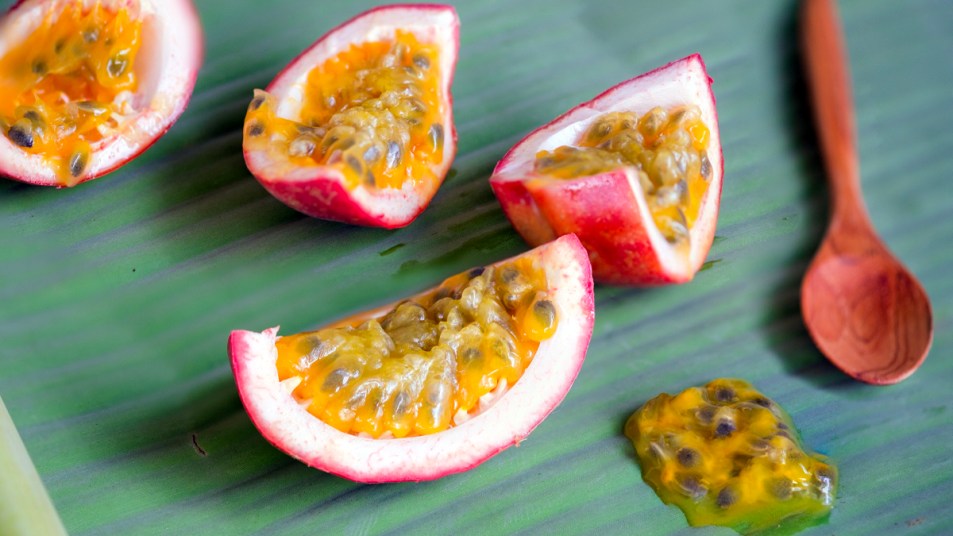3 Tropical Fruits That Soothe Digestion, Reduce Inflammation, and Keep Blood Sugar Under Control

Have you been dreaming of going on vacation in a tropical location? Whether you have the chance to go or not, you can still reap some of the benefits at home. Tropical fruits can play an important role in your diet, as they provide a range of health benefits while keeping your taste buds entertained.
And we’re not just talking about bananas, of which you probably eat plenty. Branching out from the typical apples, grapes, and oranges will not only brighten up your snacks and meals, but also give your body access to a wide range of vitamins and minerals and increase the amount of water you consume in a day.
If you’ve been avoiding the strange-looking fruits in the produce section, now is the time to pick them up and give them a try. Splurging a little on your fruits and vegetables is an excellent way to treat yourself while sticking to a healthy diet. Check out these unique, nutrition-packed fruits below.
Papaya
If you’ve ever suffered from digestive issues such as constipation, bloating, and heartburn, try reaching for a papaya instead of Pepto Bismol. Originating in the Mesoamerican region, this fruit is extremely popular in South America and also many parts of Asia. It is lauded for its fiber content and high levels of vitamins and minerals, including magnesium, potassium, vitamin C, folate, vitamin A, beta carotenes, lutein, and zeaxanthin. Beta carotenes act as powerful antioxidants that may aid in brain health and eye health. The antioxidant effects of lutein and zeaxanthin can protect the eyes from harmful rays and reduce the effects of “bad” cholesterol, or LDL cholesterol, according to the Journal of Nutrition.
So, why does papaya aid in digestive health? The fruit contains a number of powerful enzymes – namely, chymopapain and papain – which help break down or digest proteins, per the journal Biochimica et Biophysica Acta, and the Encyclopedia of Food and Health. In doing so, these enzymes can make it easier for your body to digest complex proteins and reduce the amount of inflammation in your digestive system, as noted in the Neuro Endocrinology Letters. In fact, papain is often used in OTC digestive supplements to help ease an upset stomach. Plus, the high fiber and water content can help eliminate constipation.
Now, papaya may not be the tastiest fruit depending on your preference. Some people believe that it tastes bland or has a slightly strange smell, while others enjoy the soft, melon-like texture and the mild flavor. If you want to reap the benefits of papaya but reduce its flavor, try squeezing lime over it or blending it into a tropical smoothie.
Lulo
Known as naranjilla in countries like Panama and Ecuador, and sometimes called “the golden fruit of the Andes,” the lulo fruit is native to the western region of South America. Don’t let the exterior of the lulo fruit fool you. While it looks similar to a tomato on the outside, this fruit is filled with seeds and a deep green flesh on the inside. Many people describe the flavor as tart and tangy, and similar to pineapple or a mix of lime and rhubarb. The scent is also particularly enticing.
In addition to bearing a unique flavor, the lulo fruit contains an ample serving of potassium, beta carotene, and vitamin A. It also offers a decent amount of magnesium, vitamin C, phosphorus, iron, zinc, lutein, and flavonols. Flavonols are a class of flavonoids, and have a multitude of antioxidant antimicrobial, and anti-inflammatory benefits. In effect, consuming lulo fruit can help boost your immune system and reduce inflammation in the body.
Interestingly, the lulo fruit is also touted as a good food to eat if you are trying to lose weight. The sweet and tangy flavor should manage most sugar cravings without sending your blood sugar through the roof. This fruit is nearly fat free, low in calories, and a natural diuretic, meaning it can rid the body of excess water, reduce swelling in the legs, ankles, hands, and feet, and help lower blood pressure.
Lulo fruit, or naranjilla, is available at some grocery stores depending on location, though it may be difficult to find due to its short shelf life. Fortunately, it can also be found in most frozen food aisles.
Passion Fruit
Passion fruit, or granadilla, has an incredibly sweet, tart, and tropical flavor. Many people find it difficult to compare to other fruits due to its unique texture and taste, though some characterize it as a mixture of mango, pineapple, and peach. Whether you think it tastes like these fruits or not, nearly everyone agrees that it is bursting with flavor.
On top of its rich taste, passion fruit is very high in fiber, vitamin C, vitamin A, and potassium. It also contains folate and beta carotene, making it an excellent addition to your diet if you want to boost your brain, skin, and eye health.
Better yet, passion fruit is an alkaline food and has a glycemic index of 16, meaning it is low on the GI scale and a good option for those who are pre-diabetic or diabetic. The reason? This fruit has an incredibly high fiber content, which slows down the digestive process and helps the body to slowly release sugar into the bloodstream. Thus, the extremely sweet flavor can satisfy the most demanding sweet tooth without wreaking havoc on blood sugar levels.
Wondering how to incorporate passion fruit into your diet? Many people agree that fresh passion fruit is best because it tastes like candy already. If you’d like to incorporate it into a healthy recipe, consider blending it into a fruit-and-yogurt smoothie or using it to create a marinade for fresh fish. You may also love using passion fruit to create decadent desserts, such as cheesecakes, fruit tarts, custards, and curds.













